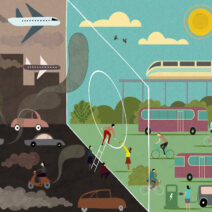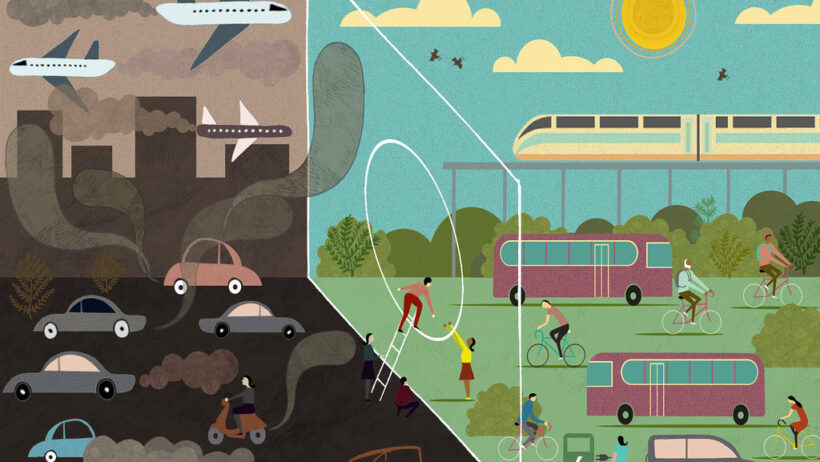When considering climate change, many people tend to overlook a silent yet profound contributor to global warming: their personal vehicles. It is a common observation that cars are convenient and essential for modern life. However, at a glance, one might not fully appreciate the environmental repercussions that accompany this convenience. Understanding your car’s climate footprint is imperative in addressing the global crisis we face. By examining the intricacies of automotive emissions, fossil fuel dependency, and the socio-economic implications of driving, one can unearth a deeper understanding of how driving directly impacts the environment.
Cars emit greenhouse gases (GHGs) such as carbon dioxide (CO2), methane (CH4), and nitrous oxide (N2O). These emissions result primarily from the combustion of fossil fuels, which, when burned, release carbon that has been stored underground for millions of years. It is crucial to recognize that the transportation sector is responsible for a significant share of global GHG emissions. In the United States alone, transportation accounts for nearly 29% of total greenhouse gas emissions, highlighting the urgency for change.
Understanding the climate footprint of a car requires exploring its life cycle. While many focus their anxieties on tailpipe emissions, the carbon footprint engendered by a vehicle extends far beyond its operation. Manufacturing processes, including sourcing materials such as steel, aluminum, and plastics, incur substantial emissions. Additionally, transportation of these components to assembly plants and the final delivery of the vehicle to consumers likewise contribute to the car’s overall environmental impact.
Moreover, the environmental implications do not cease post-manufacturing. During the lifespan of a car, maintenance and parts replacement are necessary, continuing the cycle of emissions. Ultimately, a vehicle’s demise also bears environmental weight; improper disposal or lack of recycling can lead to toxic materials contaminating the environment, thus compounding the ecological challenges we face.
When individuals choose to drive, they make decisions that fuel a system reliant on fossil fuels—a connection that fosters a dependency on non-renewable resources. This reliance not only exacerbates climate change but also entangles individuals in the socio-political consequences surrounding fossil fuel extraction and use. Oil extraction leads to deforestation, water pollution, and the displacement of communities. As people drive their cars, they are inadvertently endorsing a cycle that perpetuates these grievous injustices.
Furthermore, the scope of the climate footprint presented by cars extends into urban planning and lifestyle choices. Car-centric cities promote sprawl, leading to longer commutes and advanced infrastructure that further intensifies emissions. Everyone notices the congestion and pollution of urban environments; however, seldom do we acknowledge that it is the design of these spaces that necessitates such vehicular dependency. The allure of the automobile is closely tied to the lack of alternative transportation solutions. Consequently, enhancing public transportation options, walking paths, and cycling lanes can alleviate the burdens of car ownership and diminish our collective climate footprint.
The fascination with driving often overshadows the awareness of the impacts of our choices. People find solace in their vehicles, viewing them as symbols of freedom and independence. However, this reverence can mask an insidious reality. Each time a car is driven, a plethora of emissions is unleashed into the atmosphere and contributes to global warming. As global temperatures rise, the consequences become more pronounced: extreme weather events, melting ice caps, and habitat destruction. These are not abstract phenomena; they will influence future generations profoundly.
Additionally, alternatives to conventional gasoline-powered vehicles are on the rise. Electric vehicles (EVs) are gaining traction as a more eco-friendly choice. They emit no tailpipe emissions and have the potential to harness renewable energy sources, making them a plausible solution to reduce one’s climate footprint. However, it is essential to note that EVs are not free from environmental concerns—battery production, rare earth mineral extraction, and end-of-life disposal also contribute to their ecological impact. Thus, while the shift to electrification is necessary, it should be accompanied by systemic changes in energy production and infrastructure.
Transitioning towards a sustainable transportation model encompasses more than merely adopting electric vehicles. Policymakers must engage in comprehensive frameworks to promote carpooling, telecommuting, and active transport methods. Engaging communities in discussions about sustainable practices fosters collective responsibility, as individual choices accumulate to yield considerable change. Every decision made in favor of sustainability creates a ripple effect through personal behaviors, corporate strategies, and ultimately, governmental policies.
As stewards of the earth, it is imperative to confront the reality that our daily actions—driving being a principal player—have consequences that extend far beyond our immediate surroundings. Knowledge is a catalyst for change. By understanding the depth of our car’s climate footprint, we can shift our perspectives and take meaningful steps toward reducing our impact on the planet. The allure of driving must be weighed against the critical need for a more sustainable future. Simple shifts in behavior, such as considering fuel-efficient vehicles, utilizing public transportation, or even engaging in ride-sharing can collectively foster an environment less reliant on fossil fuels and reduce emissions.
In conclusion, recognizing the multifaceted nature of your car’s climate footprint accentuates the urgency to reconsider our transportation choices. The delicate interplay between convenience, dependency, and environmental health compels a deeper understanding and deliberate action. As global citizens, the responsibility lies with us to reconsider our fascination with cars and actively participate in fostering a sustainable future, benefiting both our planet and generations to come.






